What is Uruguay’s Latest UNESCO World Heritage Site?
- Pinterest229
- Facebook11
- Twitter5
- Reddit0
- Flipboard1
- Email0
- Buffer30
- 276shares
- Like
- Digg
- Del
- Tumblr
- VKontakte
- Buffer
- Love This
- Odnoklassniki
- Meneame
- Blogger
- Amazon
- Yahoo Mail
- Gmail
- AOL
- Newsvine
- HackerNews
- Evernote
- MySpace
- Mail.ru
- Viadeo
- Line
- Comments
- Yummly
- SMS
- Viber
- Telegram
- Subscribe
- Skype
- Facebook Messenger
- Kakao
- LiveJournal
- Yammer
- Edgar
- Fintel
- Mix
- Instapaper
- Copy Link
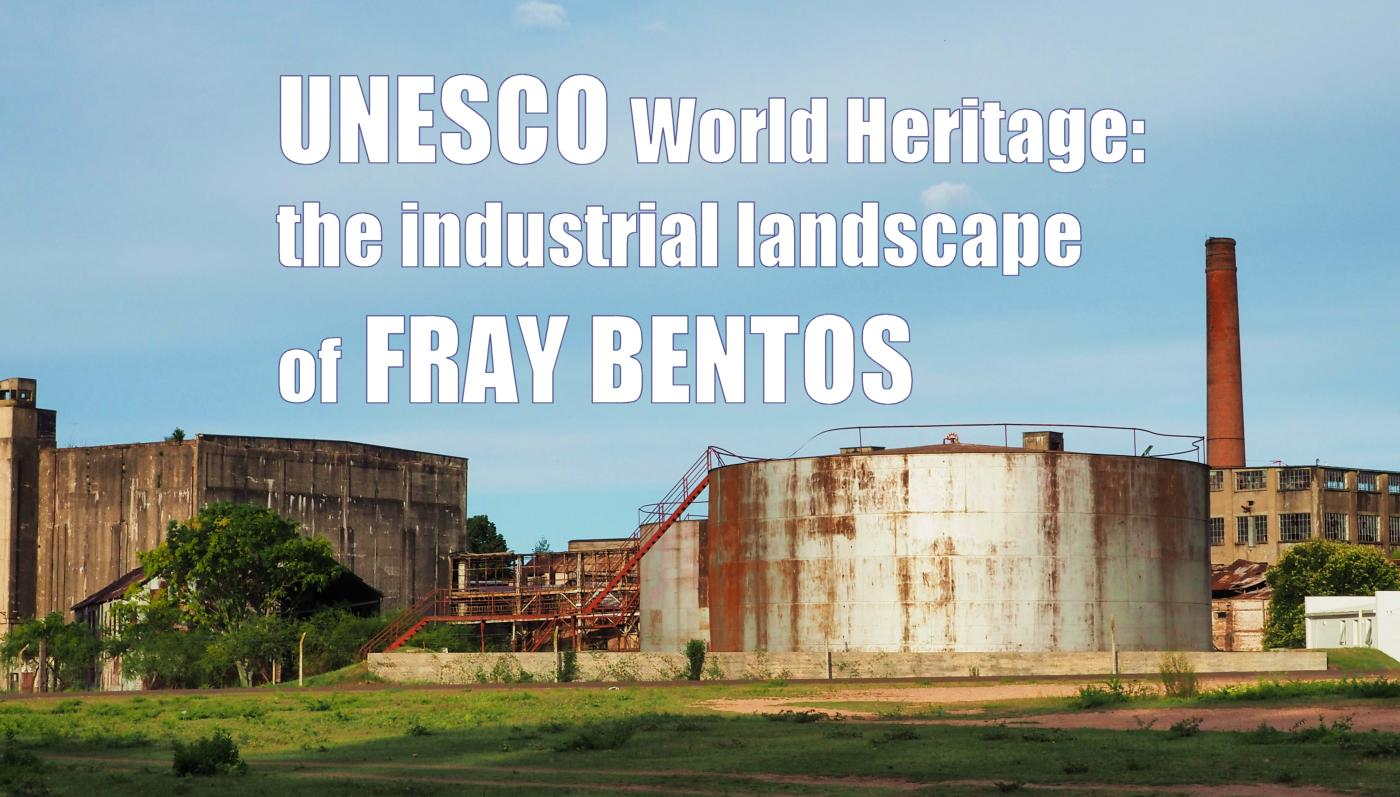
The Fray Bentos industrial landscape, a UNESCO world heritage site since 2015, as seen from the south-west. From left to right: part of the massive freezer, an old iron shed, the covered walkway and transport chain into the freezer, fuel tanks for diesel powered ships (a later addition), the slaughterhouse with the tall chimney behind.
Uruguay has a new site on the UNESCO World Heritage list. Fray Bentos Industrial Landscape was added in July 2015. The listing brings Uruguay’s total on the list to two. But they couldn’t be more different. This site “stands out as an example of early 20th century industrial development”. The Historic Quarter of the City of Colonia del Sacramento is an urban landscape which “illustrates the successful fusion of the Portuguese, Spanish and post-colonial styles.”
Some journalists have suggested that the Fray Bentos site has no place on a list next to grand structures like the Taj Majal and Hagia Sofia. But UNESCO’s World Heritage Committee considered this meat processing plant to be of Outstanding Universal Value.
We visited the site recently and learned that the factory was set up in Fray Bentos for 3 reasons:
- the abundant supply of beef in the region
- the shippable river, making global exportation convenient
- the sloping nature of the landscape, allowing gravity to be used along the production line to bring the final products to the wharf

UNESCO WORLD HERITAGE SITE since 2015, recognising the historical importance of the unique industrial landscape of FRAY BENTOS in Uruguay.
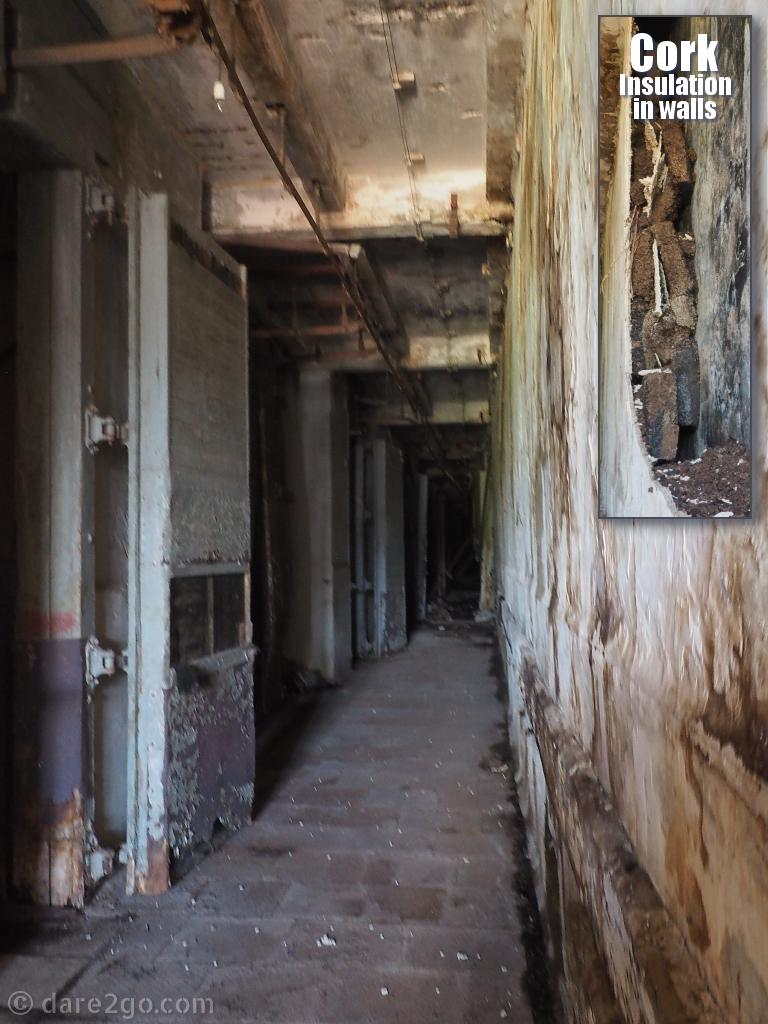
View into the freezer building. I inserted a close-up of the crumbling cork insulation which sits inside all walls.
The Original Home of Brands like OXO & Fray Bentos
Through its 117 year history this industrialised slaughterhouse became well-known as La Gran Cocina del Mundo (the great kitchen of the world). Famous brands such as Oxo and Fray Bentos were originally produced here. The export of frozen beef from South America to Europe was also pioneered from this site.
But it wasn’t only the unique history of the factory which earned its World Heritage listing. It was also the cosmopolitan community of immigrants that were brought in to work in the factory. The workforce was made up of “immigrant workers who arrived from more than 55 nations”. [UNESCO] Original workers’ housing and social institutions are part of the site.
From 1865 the Liebig Extract of Meat Company (LEMCO) produced the famous precursor to stock cubes, and exported it to Europe. This company was the brainchild of Georg Giebert, who worked with the inventor of the extract, Justus von Liebig, to produce it more cheaply, and in greater quantity, in South America. Fray Bentos canned corned beef soon joined the meat extract on the ships. The corned beef was created using the meat remains from the extract, with added fat and salt.
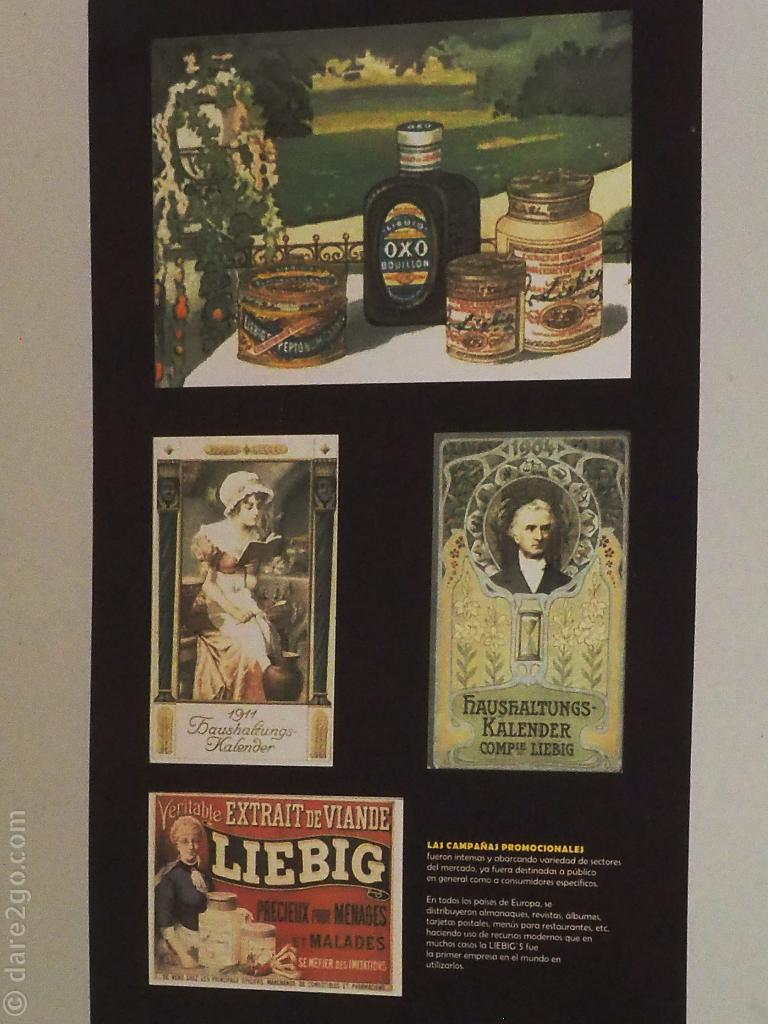
Reproductions of old Liebig products including the famous OXO stock
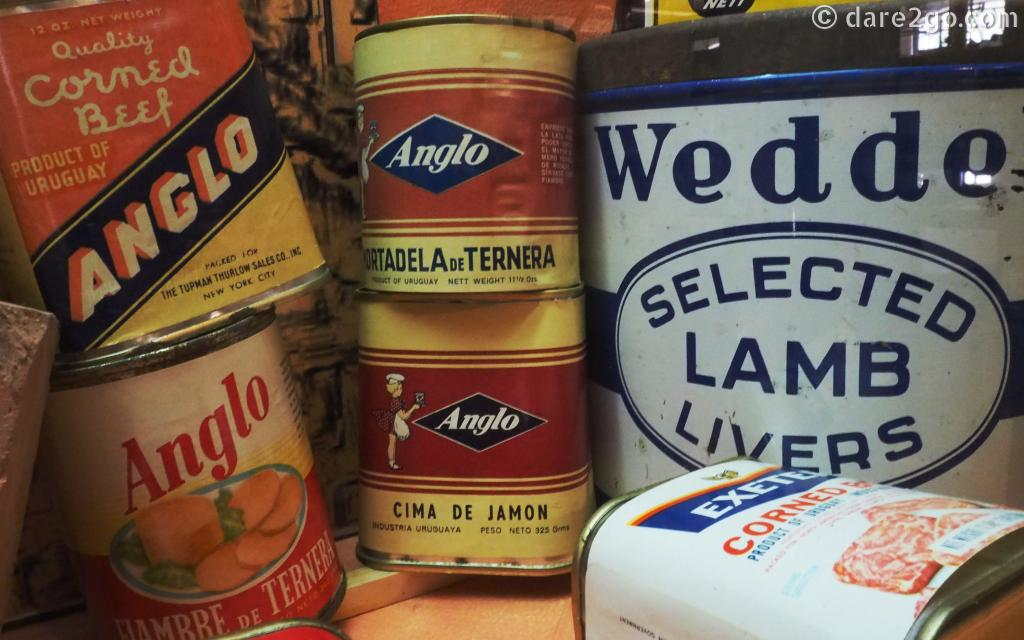
Some of the the ANGLO labels on various old cans

The old and current labels of Fray Bentos products
The New Owner ANGUS Starts to Export Frozen Meat
In 1924 the complex changed hands and the Anglo Meat Packing Plant built a huge freezer and began exporting frozen meat to Europe. The freezer was original technology and had a floor area 100 x 40 metres, 5 storeys high, and could store 18000 tons of frozen meat. 70km of pipes distributed the ammonia gas around the building. Workers were brought in from the colder regions of Europe to work in the freezer because they should be acclimatised to the severe temperatures. Even so they could only stay in the freezers for very short periods.
At the height of production there were 3 shifts per day of 1500 workers. The canned meat production continued and expanded, as other products were developed and sold under a variety of brands alongside Fray Bentos.
This factory was largely responsible for feeding the soldiers in both World Wars of the 20th Century. In 1943, 16 million cans of Fray Bentos corned beef were shipped to Europe. After WW2, as the economy in Europe improved and the equipment in the factory became out-dated, the production was gradually moved away from Fray Bentos. Ultimately the Uruguayan government was given the complex in 1971. They kept it going on a smaller scale until it was closed on October 15, 1979. (Fortunately construction on the international bridge connecting Fray Bentos to Argentina was started that year, so not all workers had to leave the area.)
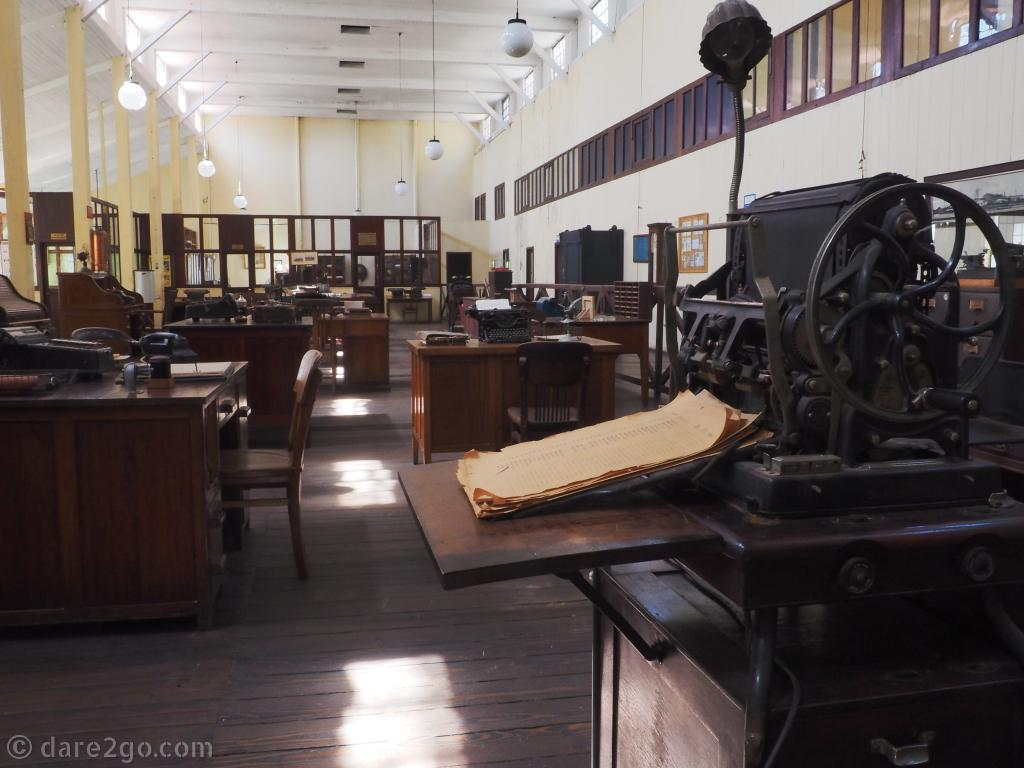
The original administration building with much of the outdated office equipment still in place
A Guided Tour of the World Heritage Complex
Our English-speaking guide, Nicolas, met us in the original administration office of the factory. It remains almost exactly as it was on that day in 1979 when business stopped. It’s like stepping into the past.
He took us to various parts of the complex:
Along the way we walked an interesting path. It was paved with thick steel plates, which had served as ballast in the empty ships on their way from Europe to collect the export products from the factory.
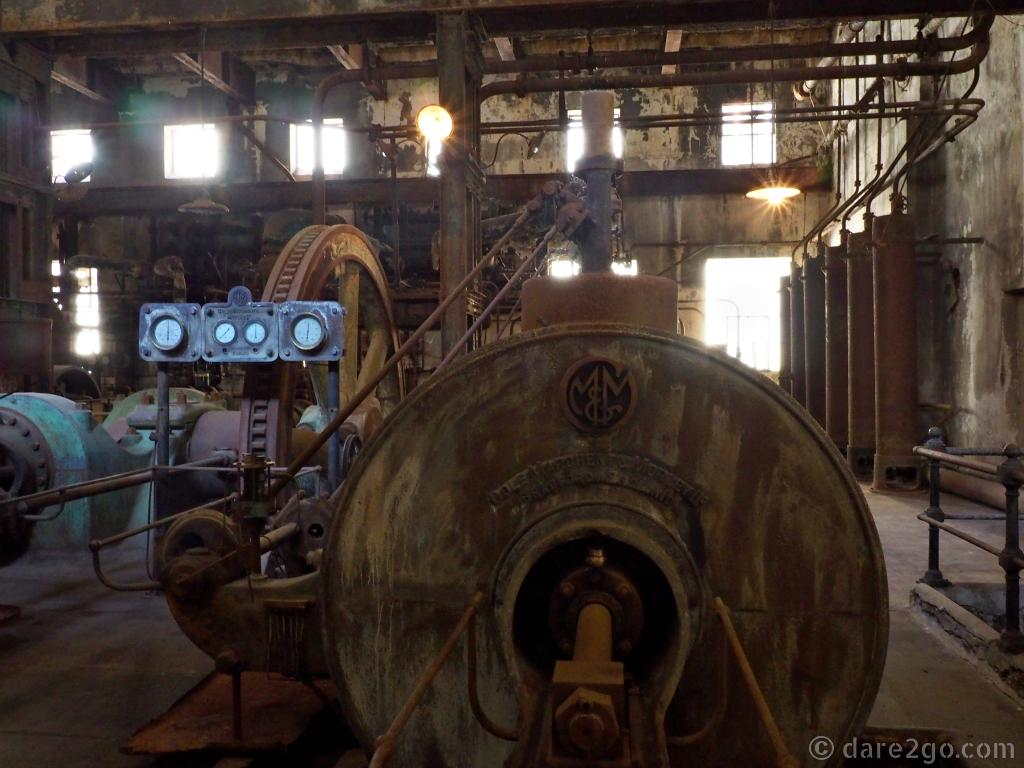
The original steam engines in the machine room of Fray Bentos. Later two large diesel generators were added (not in photo).
Machine room where they produced their own electricity with steam turbines, 3 years before Montevideo had electricity for its population.

The old power control room of the Fray Bentos industrial complex. Marble panels were used for all fronts as marble doesn’t conduct electricity.
Main control room, with its huge, marble-fronted switchboard.
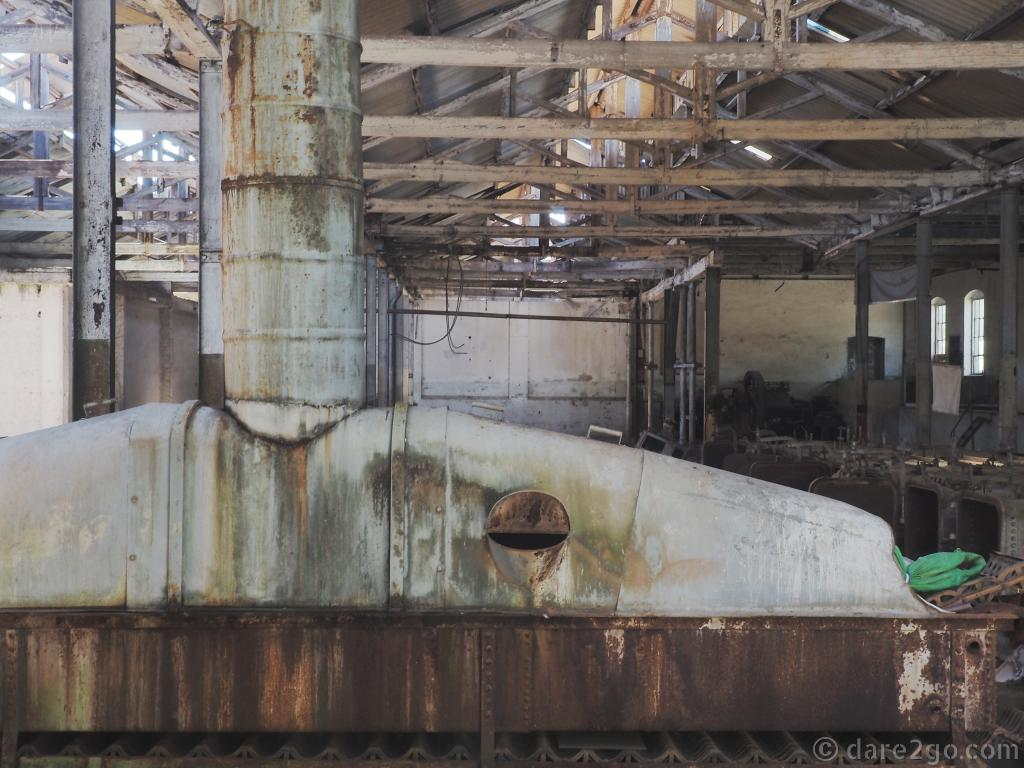
The old Corned Beef production line. This hall is not accessible to visitors (photographed through a window).
Corned beef processing section, but only to peek through the window. It’s closed to visitors because the roof isn’t structurally safe.
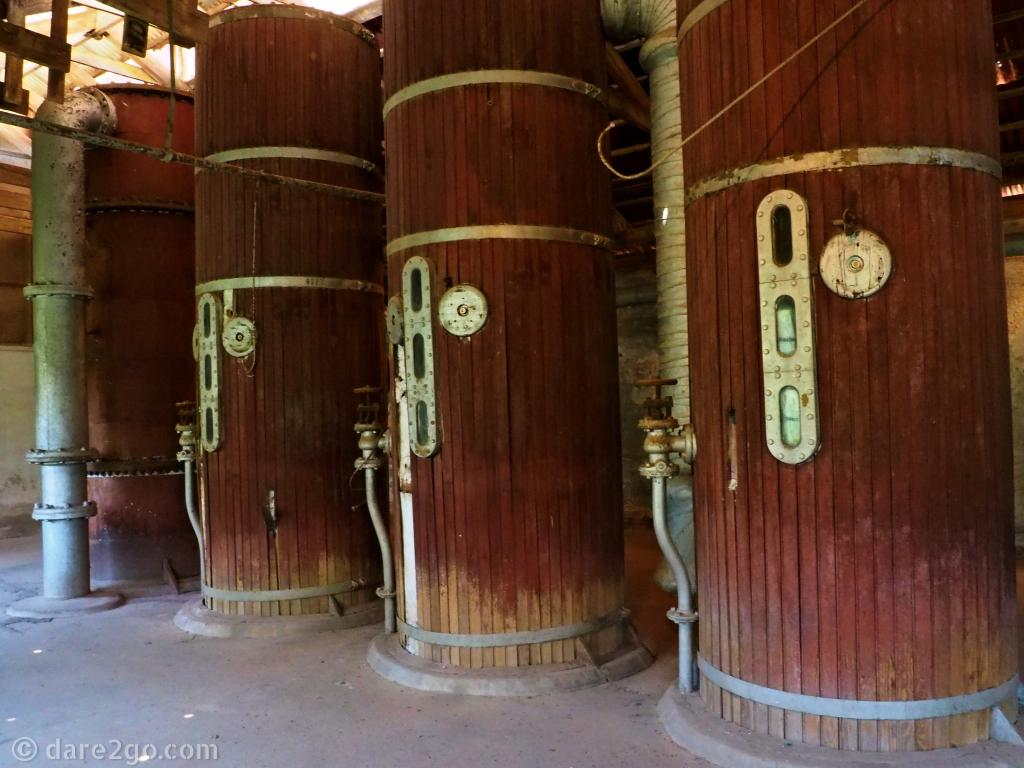
A row of boilers in the room where the original meat extract was produced.
Meat extract production area, where the meat was boiled in huge vats. It was then pressed to release the liquid, which was heated under pressure to form a concentrate with a molasses-like texture.
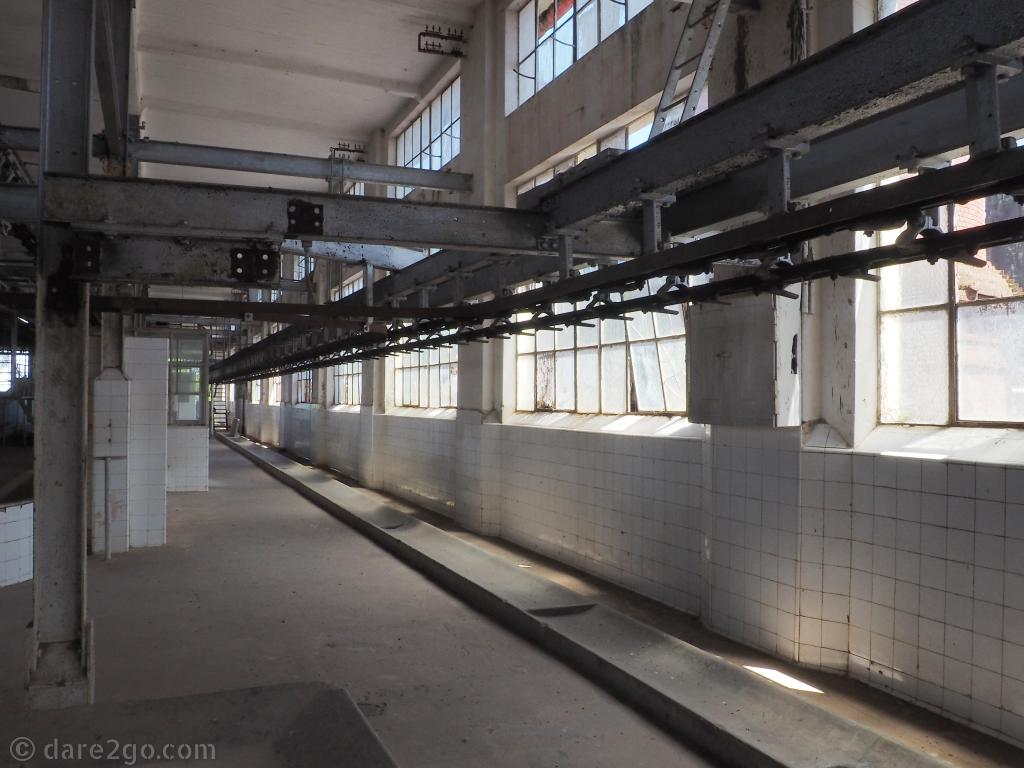
Inside the slaughterhouse of Fray Bentos
Slaughterhouse – the organisation of the production line meant that it took only 30 minutes to process a cow from death to freezer. It couldn’t have been a pleasant place to work. Nicolas told us that the workers from the slaughterhouse had to see a company psychologist regularly before they were paid.
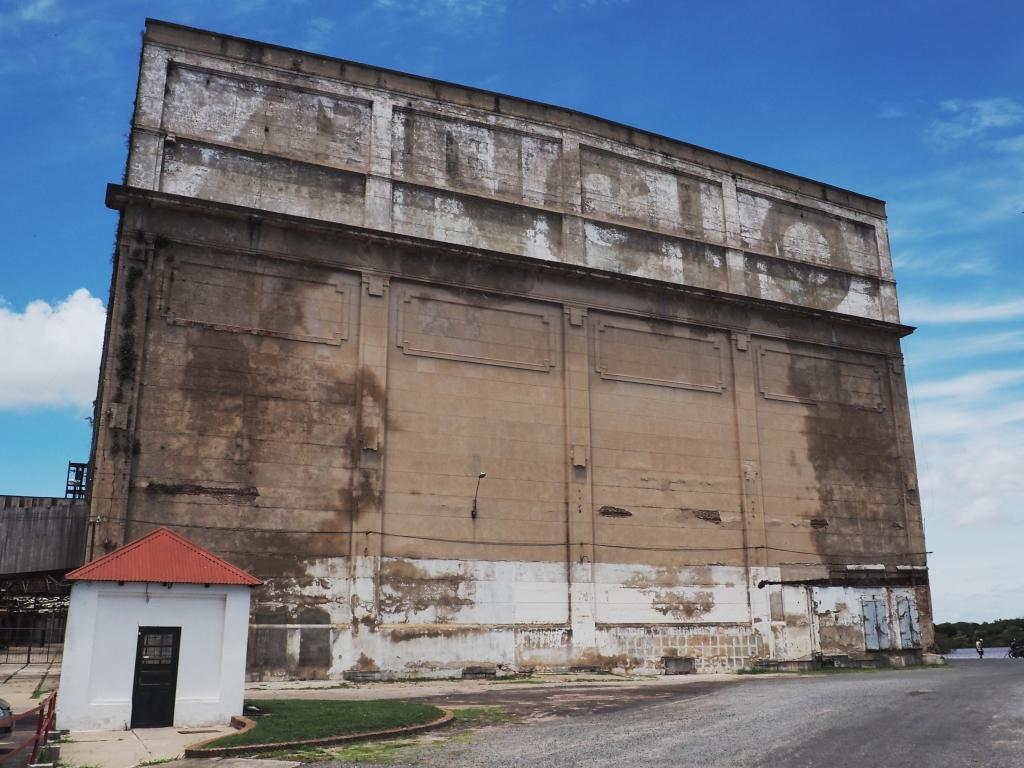
The massive freezer building as seen from port side, with very faded ANGLO writing on top
Freezer – a sloping, open walkway connects the slaughterhouse to the top floor of the huge freezer. There is a chain pulley system hanging above the walkway which utilised gravity to take the meat from the slaughterhouse to the freezer. Each floor of the freezer is divided into rooms. It was possible to maintain a different temperature in each room, depending on the grade of meat being stored. The temperature also had to match the freezers on the ships transporting the meat across the sea, to avoid compromising its preservation.
The freezer is one of the most vulnerable parts of the World Heritage site. The insulation of the freezer is all natural cork. Unfortunately the cork takes up moisture, contributing to the deterioration of the building. They haven’t yet worked out how to solve this.
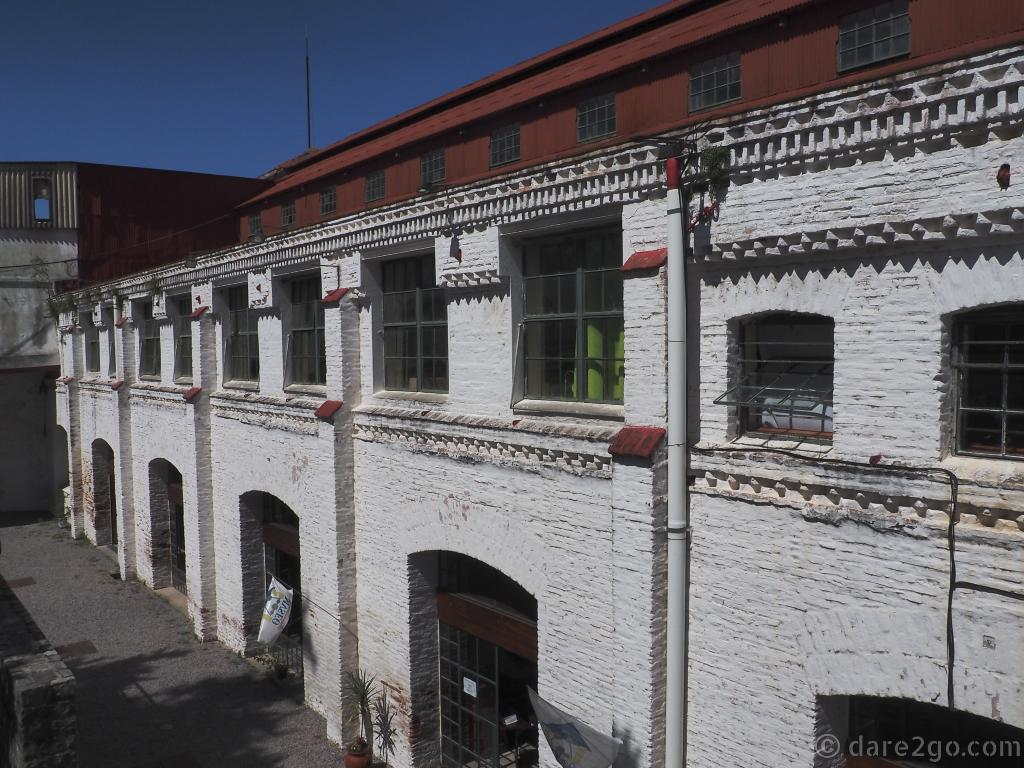
The outside of the administration block with the museum downstairs
The tour ended back at the administration building, on the ground floor. This is where the Museum of Industrial Revolution is housed. You could spend a very long time in this section. It’s full of information, photos and relics of the pioneering history of the site.
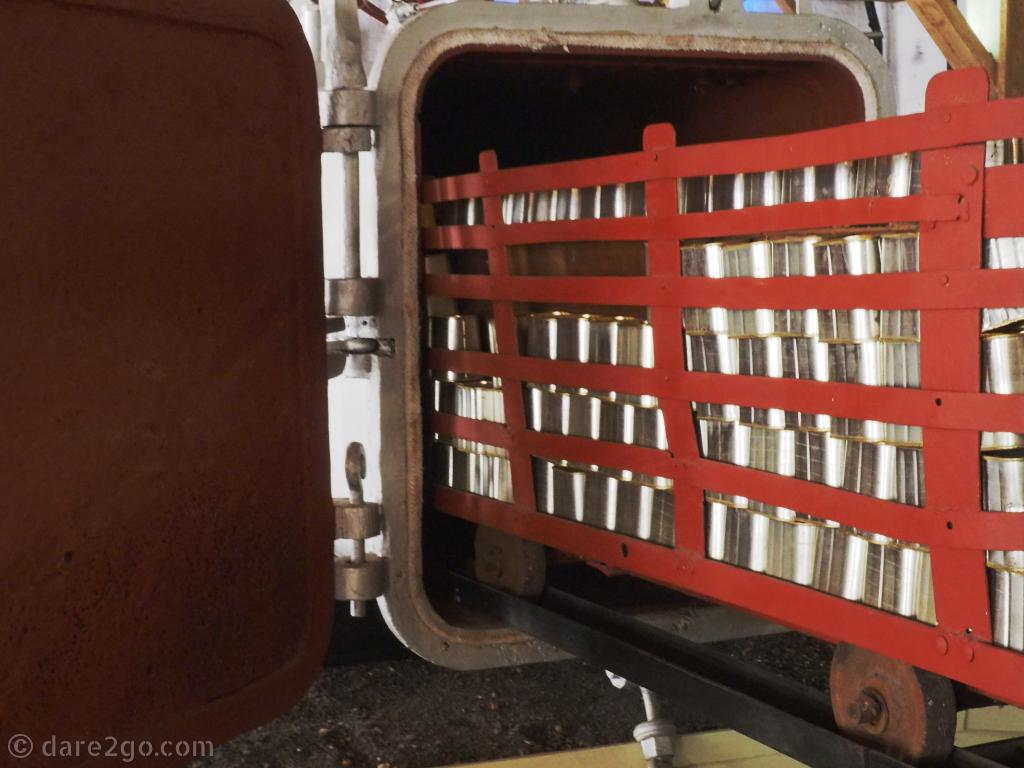
Part of Anglo Corned Beef production in Fray Bentos
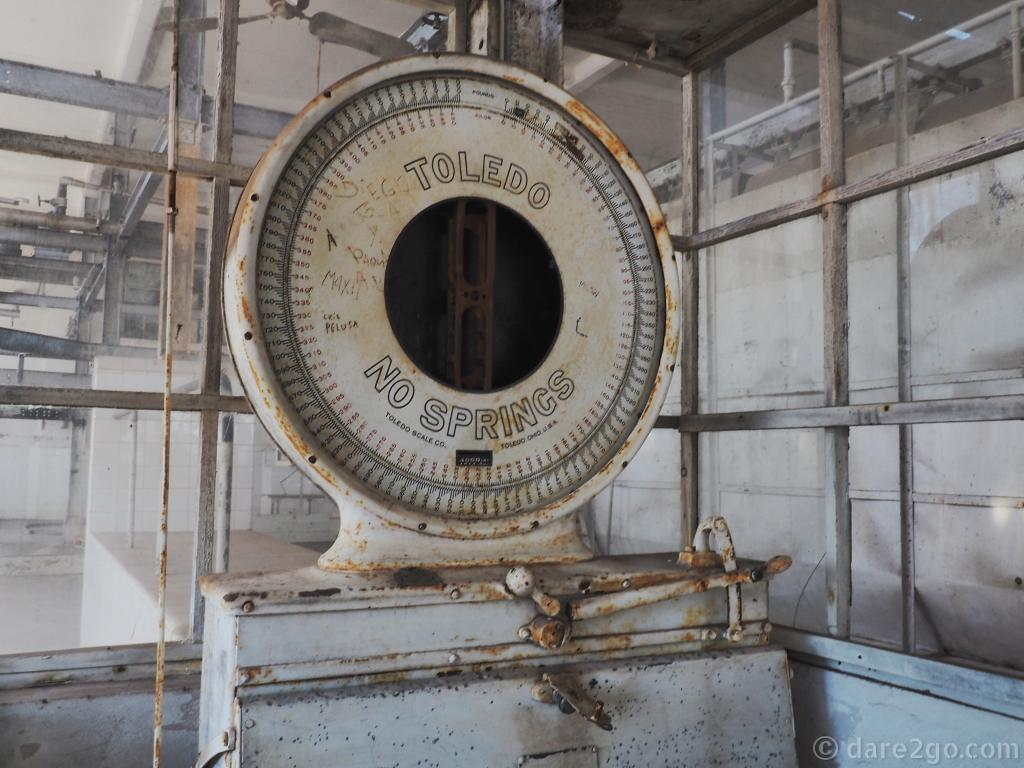
Old TOLEDO scales in the slaughterhouse
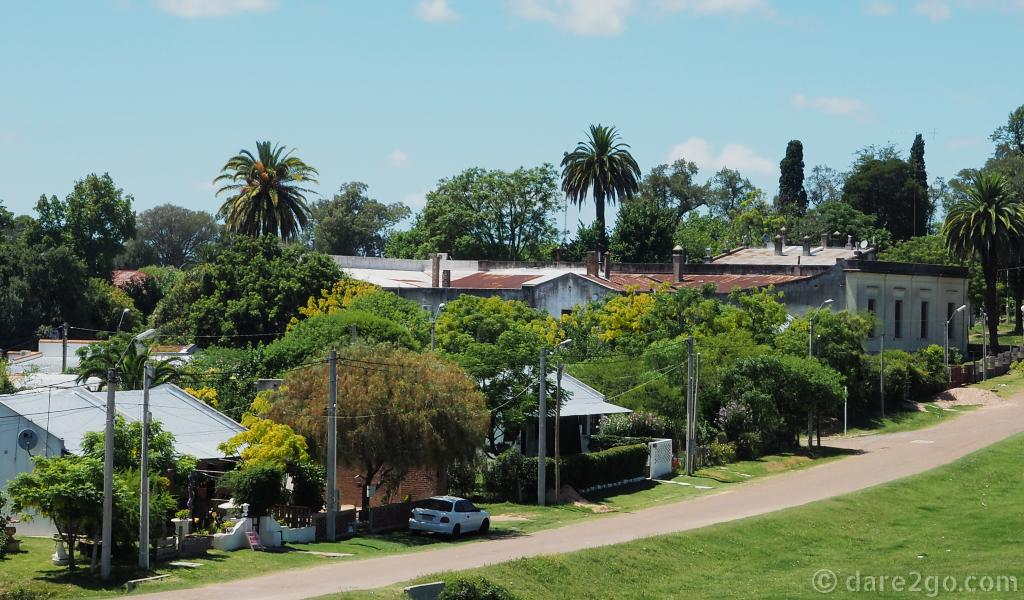
Some of the workers’ cottages behind the meat works of Fray Bentos
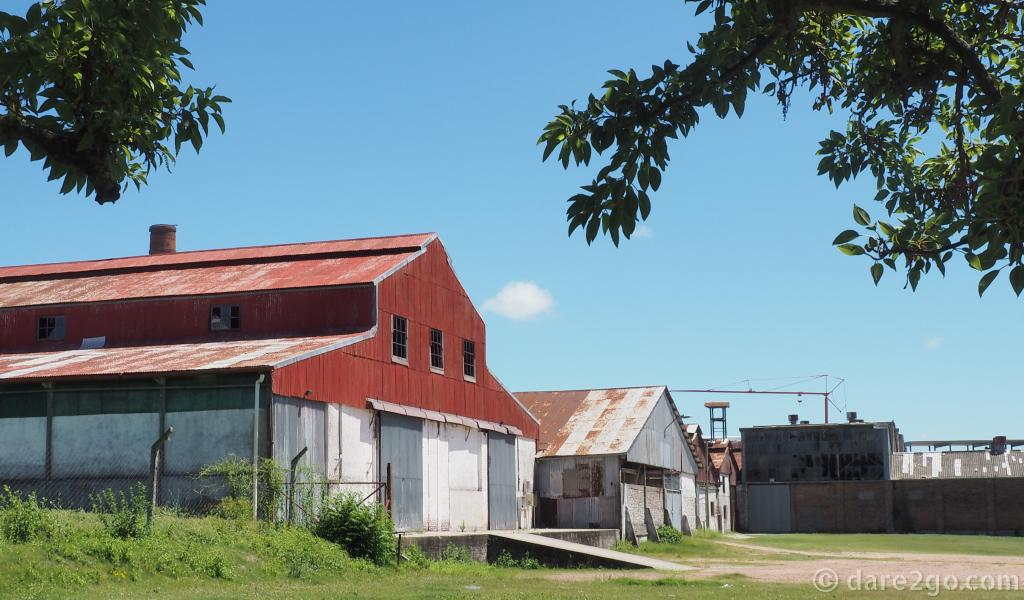
Old barns for fodder and supplies, located to the north-east of the slaughterhouse
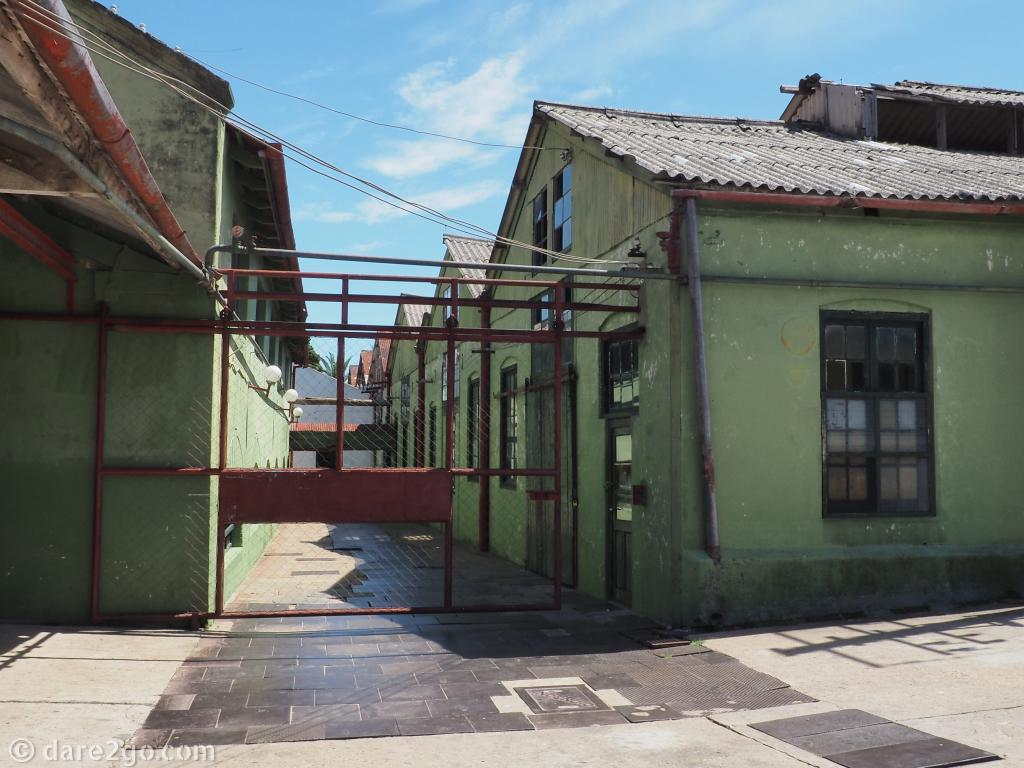
Some of the path paved with old iron plates, which were used for ballast on ships picking up freight. On the right hand side, part of the production hall for corned beef.
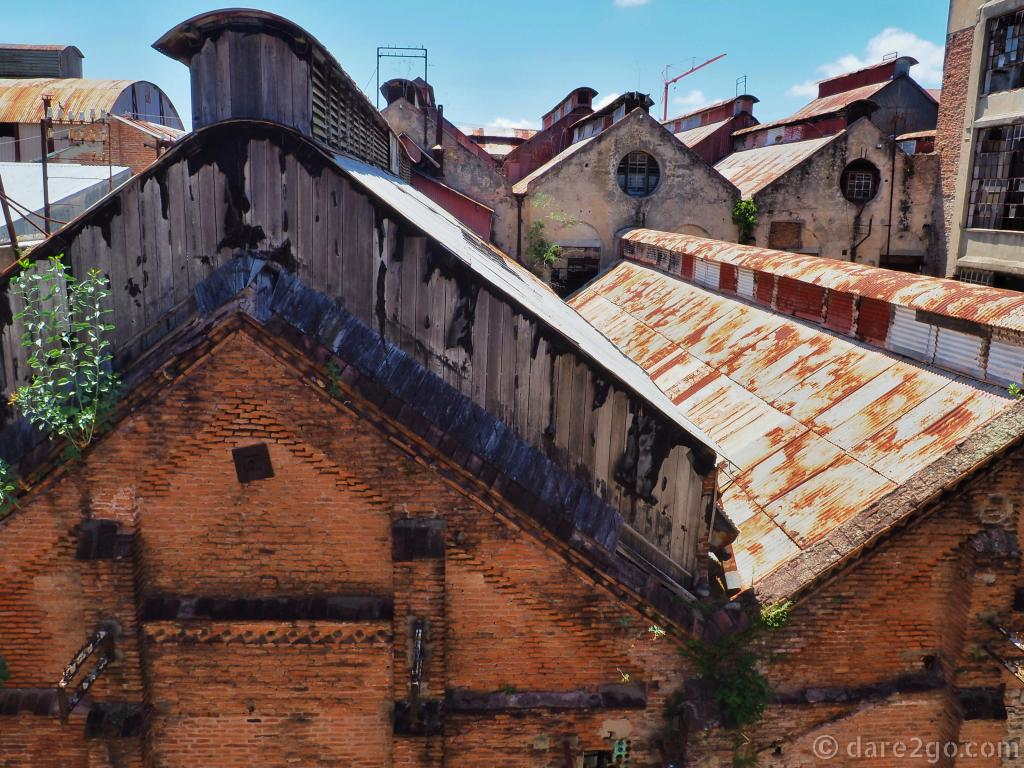
Vista across the roofs of the Fray Bentos industrial complex with the slaughterhouse to the far right
Clearly, Fray Bentos has earned its place on the World Heritage list for a number of reasons, which are set out on the UNESCO website. Primarily the pioneering aspects stand out. The factory brought the industrial revolution to the region. It also created and supported a cohesive multi-racial community around it.
Through its physical location, industrial and residential buildings as well as social institutions, the site presents an illustration of the entire process of meat production on a global scale. [UNESCO]

Two old cranes on the wharf in front of the Fray Bentos freezer building
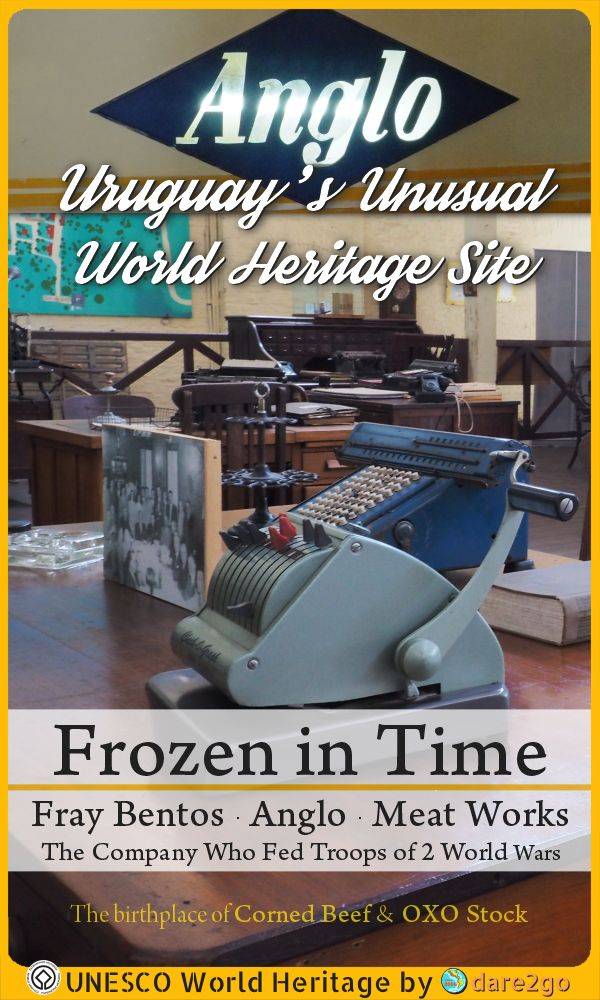
Likes this? PIN this!
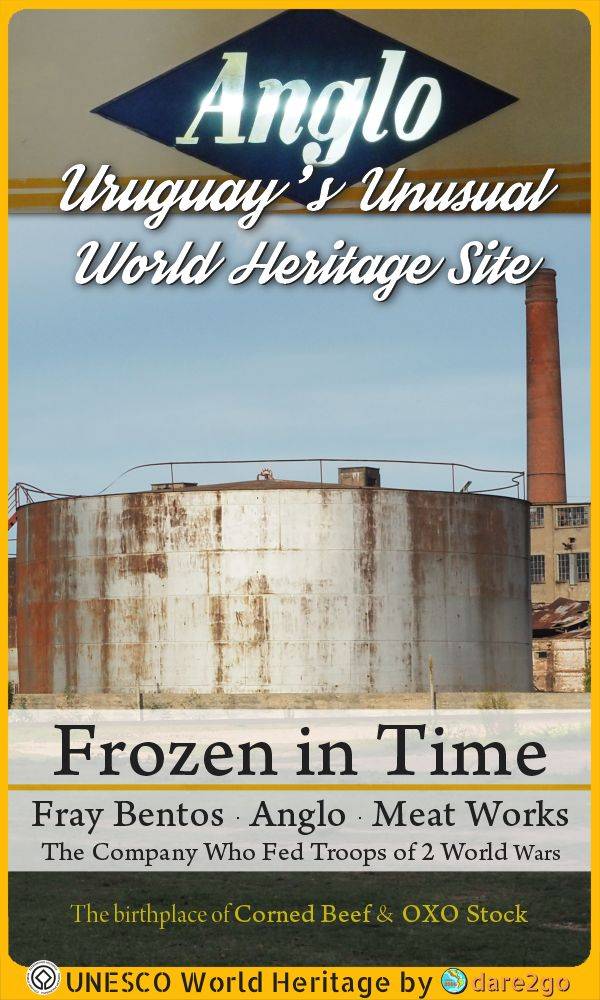
…or PIN this!
- Pinterest229
- Facebook11
- Twitter5
- Reddit0
- Flipboard1
- Email0
- Buffer30
- 276shares
- Like
- Digg
- Del
- Tumblr
- VKontakte
- Buffer
- Love This
- Odnoklassniki
- Meneame
- Blogger
- Amazon
- Yahoo Mail
- Gmail
- AOL
- Newsvine
- HackerNews
- Evernote
- MySpace
- Mail.ru
- Viadeo
- Line
- Comments
- Yummly
- SMS
- Viber
- Telegram
- Subscribe
- Skype
- Facebook Messenger
- Kakao
- LiveJournal
- Yammer
- Edgar
- Fintel
- Mix
- Instapaper
- Copy Link



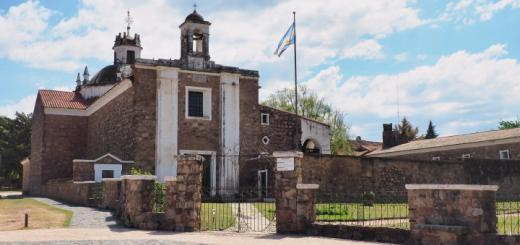









In one of those weird cosmic coincidences this was on a show on the ABC last night- talking about the development of stock cubes! (It was a show about healthy eating). How weird is that. I had no idea they were developed in Uruguay and then that this is a UNESCO site- how cool!
That is quite the cosmic coincidence! Now I’m really curious how that led you to this post. It is a really interesting place to visit, even if you’re a bit squeamish when it comes to slaughtering animals – like I am.
What an interesting post! I had never heard of the Fray Bentos meat factory before reading your post. The history you shared sounds fascinating. At first I thought an old factory was an odd site to earn UNESCO World Heritage status, but now I can see the historical significance.
I’m so pleased to have been able to enlighten you about the World Heritage listings. It was originally a surprise to us too.
I think that Fray Bentos does deserve its place on the list, and I enjoyed your post and the photos.
Thanks Paula. I think a lot of people have preconceptions about what ‘World Heritage’ means. Adding a site like Fray Bentos does something towards making it just a bit clearer.
It’s not something that appeals to me but it’s very interesting # weekend travel inspiration
Yasha, I would definitely enjoy this tour. I think the most interesting fact is about sending the food to the troops…I love it.
Indeed it is – to be largely responsible for feeding the troops in 2 wars is no small achievement.
What a great piece of history. I didn’t know that UNESCO preserved sites like this, but it’s really beautiful in its own way.
It does have its own beauty and it is truly worthy of being listed as a piece of the world’s heritage.
Oh my goodness – that’s a photographers delight!!
Wow Yasha, how fascinating! I would never have imagined that a meat plant could be a World Heritage site. It certainly has some interesting history though :-)
It was very interesting. We just met another couple today who are from England. They had also been to the site recently and were absolutely fascinated since they had grown up with Fray Bentos corned beef.
I’m quite interested in old machinery. It is quite different as a Unesco sight though!
I like your photos of this place. I do not think a place has to be “stunning” to be an UNESCO Heritage Site. There are some places that have changed the history of an area or country. I can’t imagine how many people were fed by the processed meat of this factory. When I grew up, we ate a lot of corned beef. We didn’t have the means to eat fresh meat or poultry every day.
That is so true, Ruth. I think a lot of people have the opinion that to make the UNESCO list a site must be beautiful to look at. But, it is ‘World Heritage’ that is the key. And this one is certainly that!
Wow… as the daughter of a man who worked in 2 different meat processing plants, I’ve got to say that I never thought I’d be reading about one that is World Heritage Listed! How fascinating!
Gotta say, that is really strange, who would have thought a meat plant made the cut. It creeps me out a little actually, growing up my older brother worked in a slaughterhouse, he used to come home smelling raw. Did it still have that smell? Not sure I will ever visit, so good I got to see it through your eyes.
The plant closed in 1971 so there was no smell attached. I’m a vegetarian so it was a bit disturbing, but the history is really fascinating.
I can’t help but agree that this cannot compare with so many other items on the UNESCO list, because otherwise we could be adding many more but it is nonetheless an interesting and fascinating insight into the history
After seeing it I tend to agree with their choice. It can’t always be the beautiful and exciting that we protect from our history. I really think this site is worth saving.
..this is an interesting choice UNESCO.. cool thing to write about I had no idea this existed, nor did I know it was a fusion. very cool. great pics!
This is totally a great brown field – in Czech Republic places like this were successfully transport into museums, or venues for things like a fashion show or so. I would go if there is something interesting taking place!
Very interesting. It’s important for us to remember the pieces of our history that might not be as beautiful and glamorous. Thanks for sharing.
Certainly nothing glamorous about this place. But for innovation and a unique site it definitely deserves our recognition.
I’m glad that somewhere that has so much cultural and historical significance gets a listing even if isn’t the prettiest place in the world. Great feature
Thanks Fiona. That is exactly what I think too.
Oh, so strange! I have never seen such a modern UNESCO site. It does look very interesting inside!
It’s not a classic beauty by any means. But it is recognised for lots of good reasons.
Wow this was quite interesting! I haven’t been to Uruguay would be cool to see.
Uruguay has many great places to visit. This is one of the best.
How interesting! Was in Uruguay in September and there was not much publicity about this new UNESCO wonder. Fascinating though!!
I do find the tourist info in Montevideo doesn’t have a lot of info available for the rest of Uruguay. Usually they just check the internet – which I could do myself… It’s a shame that people don’t get a bit more info about a place like this.
Incredible! I can imagine why some wonder why this is on the list. It’s an incredible choice and so valuable. I’d love to visit and take pictures. Bravo.
Go Elaine – it is truly fascinating and definitely worthy of its place on the list.
Hard to imagine a meat processing plant as a UNESCO site, but you presented some very interesting information…
Thanks Tami. We usually have the idea that it must be something wondrous and beautiful to make the list, but the truth is it must be of “Outstanding Universal Value” and this place definitely is.
This is quite a strange choice for a UNESCO heritage site. We expect to see beauty when we hear the words ‘UNESCO site’, but in this case it’s not so. I have to say though that this plant is really worth preserving. I would have liked to see it too when we were in Uruguay, but we chose to see Colonia del Sacramento instead.
I get the impression that the committee for adding to the list is diversifying somewhat. It’s good to see historical sites like this one being preserved. I find it amazing to just step back into the past in places like this.
As a military spouse I appreciate the plants contributions. A a cultural observer I appreciate the architecture, innovation and industrial contributions to the area.
It’s a truly fascinating place. As a vegetarian, I was a bit hesitant. But the ghosts didn’t bother me too much.
Whoa! This is super fascinating! What an interesting site to visit. I love places that let you feel like you’ve stepped back in time. Even to a meat processing plant! Thanks for sharing, and great photos!
Thanks for visiting Danielle – I really appreciate your comment. History is very fascinating.
Who would have thought a meat processing plant would make the list. Personally I like exploring old sites like this, lots of opportunities for great photos, like yours.
Thanks Bob. We wouldn’t have missed it. It’s just the right sort of Off-the-beaten-track we like to find. But now it’s listed, I guess it will receive a lot more visitors.
Amazing pictures! Definitely Fray Bentos is a modern marvel!
Thanks for sharing it!
Thanks for visiting our site – I hope we’ve inspired you to visit Fray Bentos some day.
That’s an incredible looking site and actually, it would be my ideal destination as opposed to most other tourist sites. I spent a whole week living next to Auschwitz concentration camp in December – it’s not the morbidness of what happened there that gets me, it’s the same haunting feelings I get when i go there..similar to an empty desert landscape!
Thanks for sharing!
Thanks Derek – so happy to have inspired such interest. The site is truly fascinating – you can almost see the ghosts out of the corner of your eye!
What fascinating articles! One place I’ve never been is Uruguay. You have enticed me there now!
I hope you enjoy Uruguay as much as we do. There are so many hidden gems to discover.